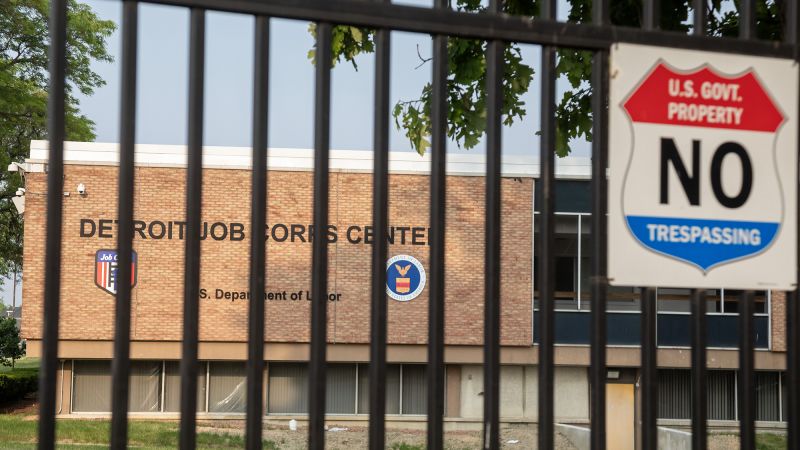**The Journey of Resilience: A Closer Look at Job Corps and Its Impact**
Eighteen months ago, Chloe Lawson found herself in a precarious situation, trapped in a cycle of low-paying jobs that offered little hope for the future. Each evening around 7 p.m., the then 19-year-old would embark on a four-mile walk to her job at Subway, where she worked the challenging overnight shift for just over the federal minimum wage of $7.25. Following eight hours of labor, she would return to the streets of Splendora, Texas, a town located near Houston, seeking a safe place to rest, often winding up in unpredictable and unsafe accommodations.
Lawson’s early experiences left her feeling hopeless. At that point in her life, she was navigating the difficulties of being without family or friends to support her. “I honestly didn’t have a future,” she remarked, encapsulating the despair she felt. However, her life took a significant turn over the next year and a half. Now at 21, she is poised to enter a promising career as a train conductor, an opportunity that comes with an attractive starting salary of $80,000 annually. This transition is largely credited to her participation in a vocational training program designed to uplift individuals like her.
However, this program, known as Job Corps, has recently encountered serious challenges. Lawson is among approximately 21,000 students whose training was abruptly disrupted by the Department of Labor’s announcement in late May to pause operations at Job Corps, a long-standing initiative aimed at assisting low-income and at-risk youth. Launched more than six decades ago during President Lyndon B. Johnson’s War on Poverty, Job Corps has been instrumental in providing education and vocational training opportunities.
The Labor Department cited budget deficits and unsatisfactory outcomes as the reasons for the suspension of contracts at 99 private-contractor-operated Job Corps centers across the country. This nonetheless has raised significant concerns given the historical context and success of the program. Secretary of Labor Lori Chavez-DeRemer asserted that the program’s analysis highlighted issues of safety and fiscal sustainability, asserting a commitment to assisting students during this transitional phase.
Despite the Labor Department’s concerns, the National Job Corps Association has contested these claims, arguing that recent evaluations misrepresented data affected by the pandemic. They suggest that safety issues were exaggerated and merely reflect incidents that occurred following strict reporting obligations. The potential closure of Job Corps poses serious economic implications, as this program has historically served as a vital pipeline of skilled trade workers, especially against the backdrop of a labor shortage as the country seeks to revitalize its manufacturing sector.
Labor market experts, like Rachel Sederberg, emphasized the urgent need for workers across various skilled trade positions, such as healthcare, maintenance, and transportation—a need that could be underscored in the coming years. The sudden pause left students, like Lawson, in a lurch, with some returning to homelessness, prompting lawsuits from center operators in an attempt to challenge the government’s decision.
A recent reprieve from a federal judge stalled the suspension temporarily, although the future of Job Corps hangs in the balance, heavily reliant on ongoing funding from Congress. Meanwhile, Labor Department representatives indicated a commitment to providing pathways for current students to continue their training and connect with employment opportunities during this uncertain transition.
The ramifications of Job Corps’ potential closure extend beyond the immediate impact on students. Industry professionals express concern over losing avenues to recruit and train the next generation of workers to replace retiring tradespeople. The risk is particularly pronounced within essential sectors, including transportation and healthcare, where the demand for skilled labor is ever-growing.
Real-life anecdotes like those of Jasmine Geib further showcase the transformative power of programs like Job Corps. Once on a path to financial instability, Geib’s experience with Job Corps led her to a stable job as a licensed conductor and engineer, earning a six-figure salary. As she and Lawson join advocacy efforts to promote Job Corps, the urgent need for reform rather than straight closure becomes increasingly apparent. “They’re helping kids that had no future make something of themselves,” Lawson articulated, showcasing the program’s importance in providing opportunities for economically disadvantaged youth.
Ultimately, the futures of many young adults hang in the balance as the debate around Job Corps unfolds. The organization represents more than just a training program; it is a crucial stepping stone for individuals seeking pathways to fulfilling, stable employment while addressing broader manufacturing and labor needs across the United States.










